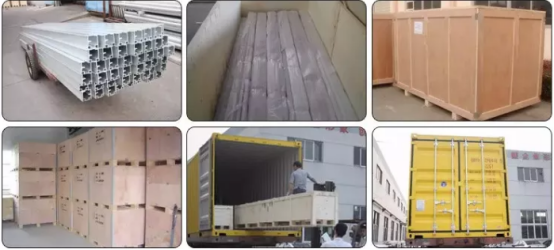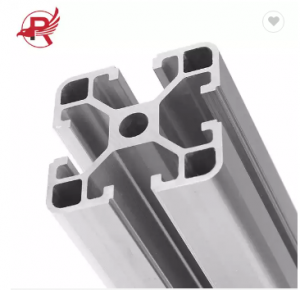Factory Wholesale 6061 6062 6063 T6 Metal Aluminum Alloy Aluminum Angle Bar Manufacturer

|
Product Name
|
aluminum angle bar profiles
|
|
Material
|
Aluminum Alloy 6063,6061,6005,6463,6005A,6060,6101,6082,6351
|
|
Temper
|
T4,T5, T6,T66,T52
|
|
Surface
|
Anodize, electrophoresis, powder coating, PVDF coating, wood grain painting,brushed
|
|
Color
|
Silver white, bronze, gold, black, champagne, customized
|
|
Wall Thickness
|
>0.8mm, 1.0, 1.2, 2.0, 4.0…
|
|
Shape
|
Square, Round, Flat, Oval, Irregular...
|
|
Length
|
Normal=5.8m, 5.9m, 6m, 3m-7m is customized size
|
|
MOQ
|
3 ton/order,500 kgs/item
|
|
OEM Service Production
|
Customers’ drawings/ samples or design service offered
|
|
Guarantee
|
Surface color can be stable for 10-20 years indoor using
|
|
Fabrication
|
Milling, Drilling, Cutting, CNC,Windows and Doors frames
|
|
Advantages Features
|
1.Air proof, Water proof, Heat insulation, Thermal insulation, Anti-aging, Resist impacts
2.Environmentally friendly 3.Corrosion resistant, shinging 4.Modern appearance |
|
Testing Standard
|
GB,JIS,AAMA,BS,EN,AS/NZS,AA
|



Construction Field: widely used in the production of building components such as door and window frames, curtain walls, roof structures, stair handrails, balcony railings, etc., which can not only reduce the weight of buildings, but also improve the beauty and durability of buildings.
Mechanical Manufacturing Field: often used to manufacture lightweight structural parts, brackets, frames, workbenches, etc., which can reduce the weight of mechanical equipment and improve operating efficiency and energy saving effects while ensuring mechanical strength.
Transportation Field: widely used in the manufacture of vehicles such as automobiles, ships, and rail transit, such as automobile body frames, chassis components, luggage racks, ship decks, cabin structures, and body structures of rail transit vehicles, which help to achieve lightweight transportation and reduce energy consumption and emissions.
Aerospace Field: Due to the advantages of light weight, high strength, and corrosion resistance, aluminum angle steel also has important applications in the aerospace field, such as aircraft wing structures, fuselage frames, engine components, etc., which are of great significance for reducing the weight of aircraft and improving flight performance.
Electrical and Electronic Fields: due to its good conductivity and heat dissipation performance, it can be used to manufacture electrical equipment housings, frames, radiators, and protective covers for wires and cables.
Other Fields: It can also be used in furniture manufacturing, display rack production, sports equipment, agricultural facilities, garden landscaping and other fields, such as making furniture frames, display rack support structures, basketball rack brackets, greenhouse frames, etc.

Note:
1.Free sampling, 100% after-sales quality assurance, Support any payment method;
2.All other specifications of round carbon steel pipes are available according to your requirement (OEM&ODM)! Factory price you will get from ROYAL GROUP.
1. Raw material preparation
Aluminum ingot selection: According to the required performance of angle aluminum, select suitable aluminum ingots as the main raw material. Common ones include 1060 aluminum ingots with higher purity, and 6061, 6063 and other alloy aluminum ingots with specific alloy elements.
Additive preparation: In order to improve the performance of aluminum alloy, some alloy element additives such as magnesium (Mg), silicon (Si), copper (Cu), etc. need to be added. These additives are added in a specific proportion to obtain the desired mechanical properties and processing properties.
2. Melting
Furnace loading: The selected aluminum ingots and additives are loaded into the furnace in a certain order. Usually, the aluminum ingots are loaded first, and the additives are added after a part of them is melted to ensure uniform mixing.
Melting and stirring: The furnace is heated to melt the aluminum ingots. During the melting process, the stirring device is used to stir the aluminum ingots sufficiently so that the alloy elements are evenly distributed in the aluminum liquid, and impurities and gases in the aluminum liquid are removed at the same time.
Temperature and composition control: Strictly control the melting temperature, generally around 700-750℃, and monitor the composition of the aluminum liquid in real time through equipment such as spectrometers to ensure that it meets the quality requirements of the product.
3. Casting
Mold preparation: Design and manufacture the corresponding casting mold according to the specifications and shape of the angle aluminum. The mold is usually made of high-strength cast iron or steel with good wear resistance and thermal stability.
Casting: Pour the smelted aluminum alloy liquid into the mold. Under the action of gravity or pressure, the aluminum alloy liquid fills the mold cavity, and then cools naturally or by forced cooling to solidify the aluminum alloy liquid to form the blank of the angle aluminum.
4. Extrusion
Blank heating: Heat the cast aluminum blank to about 400-500℃ to reach a temperature range suitable for extrusion. At this time, the aluminum alloy has good plasticity and is easy to extrude.
Extrusion molding: Put the heated billet into the extrusion barrel of the extruder, and apply huge pressure through the extrusion rod to extrude the aluminum alloy billet from the die hole of the die to form an angle aluminum with a specific cross-sectional shape and size. During the extrusion process, the extrusion speed and pressure must be controlled to ensure the dimensional accuracy and surface quality of the angle aluminum.
5. Surface treatment
Degreasing and cleaning: Degrease the extruded angle aluminum to remove oil and impurities on the surface, and then rinse it with clean water to prepare for subsequent surface treatment.
Anodizing: This is one of the commonly used surface treatment methods for angle aluminum. A hard, wear-resistant and corrosion-resistant oxide film is formed on the surface of the angle aluminum by electrolysis. The thickness of the oxide film is usually between 10 and 30 microns and can be adjusted according to different usage requirements. The anodized angle aluminum can obtain various colors such as silver, gold, black, etc. through electrolytic coloring or dyeing processes to increase its decorativeness.
Electrophoretic coating: Apply a layer of organic coating on the surface of the angle aluminum, and make the coating evenly adhere to the surface of the angle aluminum by electrophoresis. Electrophoretic coating can improve the corrosion resistance and weather resistance of angle aluminum, and at the same time make the surface of angle aluminum have good gloss and feel.
Powder spraying: The powdered coating is sprayed on the surface of angle aluminum through a spray gun, and then the powder coating is cured into a film after high-temperature baking. The coating of powder spraying has high hardness, wear resistance and corrosion resistance, a wide range of color selection, and good environmental performance.
6. Cutting and processing
Cutting: According to customer needs, use cutting equipment to cut the angle aluminum into specified lengths. Common cutting methods include sawing and shearing. Sawing can achieve higher cutting accuracy and is suitable for occasions with high size requirements; shearing is more efficient and suitable for mass production.
Machining: According to specific use requirements, the angle aluminum is further machined, such as drilling, tapping, bending, etc. Drilling is used to install connectors or other accessories; tapping is to process internal threads on the basis of drilling for use with connectors such as bolts; bending can process the angle aluminum into various angles and shapes to meet different installation and use requirements.
7. Inspection and packaging
Appearance inspection: mainly check the surface quality of angle aluminum, including whether there are scratches, bumps, bubbles, color difference and other defects, to ensure that the surface of angle aluminum is smooth and the color is uniform.
Dimensional accuracy measurement: use measuring tools such as calipers, micrometers, rulers, etc. to measure the side length, thickness, angle, length and other dimensions of angle aluminum to ensure that they meet the specifications of the product. The control of dimensional accuracy is crucial for the installation and use of angle aluminum.
Mechanical property testing: through tensile tests, hardness tests and other methods, the mechanical properties of angle aluminum, such as tensile strength, yield strength, hardness, etc., are tested to ensure that they meet the relevant standards and use requirements.
Packaging: The qualified angle aluminum is packaged, usually using plastic film, paper packaging or wooden pallet packaging to prevent damage during transportation and storage. The product specifications, models, quantity, production date and other information will also be indicated on the packaging for easy identification and management.

Packaging is generally naked, steel wire binding, very strong.
If you have special requirements, you can use rust proof packaging, and more beautiful.

Transportation: Express (Sample Delivery), Air, Rail, Land, Sea shipping (FCL or LCL or Bulk)

Our Customer

Q: Are u a manufacturer?
A: Yes, we are spiral steel tube manufacturer locates in Daqiuzhuang village, Tianjin city, China
Q: Can I have a trial order only several tons?
A: Of course. We can ship the cargo for u with LCL serivece.(Less container load)
Q: Do u have payment superiority?
A: For big order, 30-90 days L/C can be acceptable.
Q: If sample free?
A: 30% in advance by T/T, 70% will be before shippment basic on FOB; 30% in advance by T/T, 70% against the copy of BL basic on CIF.
Q: Are you gold supplier and do trade assurance?
A: We 13 years gold supplier and accept trade assurance.












